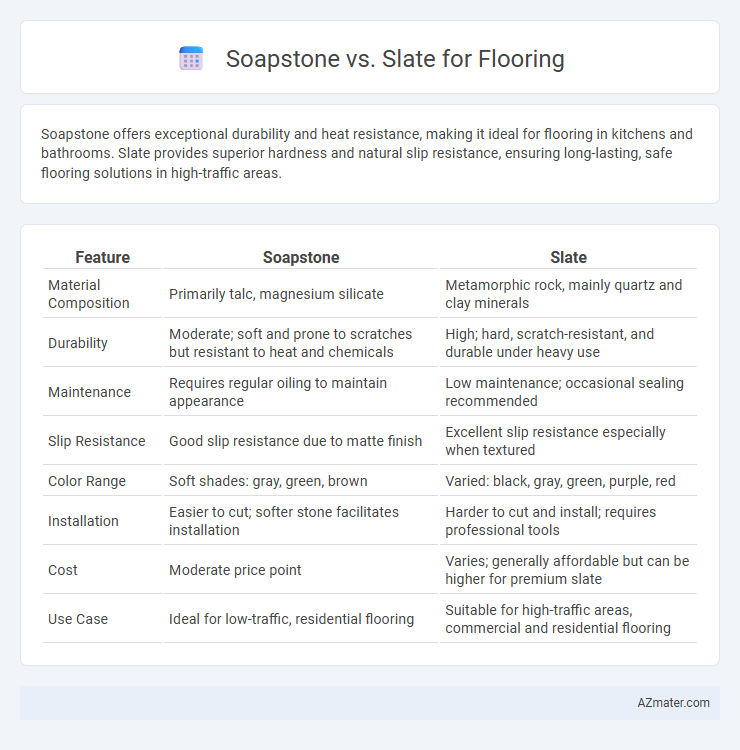Soapstone offers exceptional durability and heat resistance, making it ideal for flooring in kitchens and bathrooms. Slate provides superior hardness and natural slip resistance, ensuring long-lasting, safe flooring solutions in high-traffic areas.
Table of Comparison
| Feature | Soapstone | Slate |
|---|---|---|
| Material Composition | Primarily talc, magnesium silicate | Metamorphic rock, mainly quartz and clay minerals |
| Durability | Moderate; soft and prone to scratches but resistant to heat and chemicals | High; hard, scratch-resistant, and durable under heavy use |
| Maintenance | Requires regular oiling to maintain appearance | Low maintenance; occasional sealing recommended |
| Slip Resistance | Good slip resistance due to matte finish | Excellent slip resistance especially when textured |
| Color Range | Soft shades: gray, green, brown | Varied: black, gray, green, purple, red |
| Installation | Easier to cut; softer stone facilitates installation | Harder to cut and install; requires professional tools |
| Cost | Moderate price point | Varies; generally affordable but can be higher for premium slate |
| Use Case | Ideal for low-traffic, residential flooring | Suitable for high-traffic areas, commercial and residential flooring |
Introduction to Soapstone and Slate Flooring
Soapstone flooring offers exceptional durability and natural resistance to stains and heat, making it a popular choice for kitchens and high-traffic areas. Slate flooring, known for its rich texture and variety of colors, provides a slip-resistant surface that enhances both indoor and outdoor spaces. Both materials deliver unique aesthetic appeal and long-lasting performance, with soapstone featuring a smooth, matte finish and slate showcasing layered, crystalline patterns.
Key Differences Between Soapstone and Slate
Soapstone and slate differ significantly in composition, with soapstone primarily made of talc providing a softer texture, while slate consists of metamorphic rock, offering greater hardness and durability. Soapstone's heat resistance and non-porous nature make it ideal for warm, moisture-prone areas, whereas slate's layered structure presents excellent slip resistance and a variety of natural color tones suitable for high-traffic floors. Maintenance requirements also contrast, as soapstone needs periodic oiling to maintain its appearance, while slate requires sealing to prevent staining and chipping over time.
Appearance and Aesthetic Qualities
Soapstone flooring boasts a smooth, matte finish with subtle veining, offering a warm, natural look that complements rustic and modern interiors. Slate flooring features a textured, layered appearance with a range of colors from deep grays to earthy reds, creating a rich, dynamic visual appeal ideal for both traditional and contemporary spaces. The choice between soapstone and slate hinges on desired surface texture and color variation, where soapstone provides consistent elegance and slate delivers vibrant, organic character.
Durability and Longevity Comparison
Soapstone flooring offers exceptional durability due to its dense, non-porous structure, making it resistant to stains, scratches, and heat while requiring minimal maintenance. Slate, also highly durable, features natural cleft texture and hardness that resists wear and moisture but may require sealing to prevent staining and chipping. Both materials provide long-lasting flooring solutions, with soapstone typically outperforming slate in resilience against everyday impacts and chemical exposure.
Maintenance Requirements for Each Stone
Soapstone flooring demands minimal maintenance due to its non-porous nature, resisting stains and moisture without frequent sealing. Slate flooring requires regular sealing and occasional polishing to prevent water damage and maintain its appearance, as it is more porous and prone to scratches. Both stones benefit from routine cleaning with pH-neutral cleaners to preserve their durability and finish.
Cost and Value Analysis
Soapstone flooring typically costs between $12 and $25 per square foot, offering excellent durability and resistance to stains and heat, which can increase its long-term value. Slate flooring ranges from $15 to $30 per square foot, with a broader variety of colors and textures, making it appealing for high-end applications but often requiring more maintenance. When comparing cost and value, soapstone provides a more cost-effective option for durability and low upkeep, while slate offers greater aesthetic versatility with potentially higher installation and maintenance expenses.
Installation Process and Considerations
Soapstone flooring requires precise cutting due to its softer nature, making professional installation crucial to avoid chipping or cracking, while its non-porous surface demands minimal sealing. Slate, being more rigid and dense, needs careful handling to prevent breakage during installation and often requires grout sealing to protect against moisture. Both materials benefit from a stable subfloor and proper acclimation before installation to ensure durability and longevity.
Environmental Impact and Sustainability
Soapstone flooring offers superior sustainability due to its natural abundance, low energy extraction processes, and excellent durability, minimizing replacement frequency and waste. Slate flooring, while also durable, involves more intensive quarrying that can lead to greater habitat disruption and higher carbon emissions. Both materials are recyclable and non-toxic, but soapstone's lower environmental footprint makes it a more eco-friendly choice for sustainable flooring.
Best Uses and Room Suitability
Soapstone is ideal for kitchen countertops, bathrooms, and laundry rooms due to its non-porous, stain-resistant nature and ability to withstand heat, making it perfect for high-moisture and high-use areas. Slate flooring suits entryways, living rooms, and outdoor patios because of its durability, slip resistance, and natural textured surface that can handle heavy foot traffic and varying weather conditions. Both materials offer unique aesthetic appeal but require different maintenance levels, with soapstone needing occasional oiling and slate needing sealing to protect against water damage.
Pros and Cons: Soapstone vs Slate Flooring
Soapstone flooring offers exceptional durability, natural resistance to stains and heat, and a smooth, matte finish that requires minimal maintenance but can be prone to scratches and dents. Slate flooring provides a highly durable, slip-resistant surface with varied textures and colors, making it visually appealing and suitable for high-traffic areas, though it demands regular sealing to prevent moisture damage and may chip or crack under heavy impact. Both materials are excellent choices for natural stone flooring, with soapstone excelling in stain resistance and slate favored for its hardness and aesthetic variety.

Infographic: Soapstone vs Slate for Flooring
 azmater.com
azmater.com